Pediatric HAL® S2225
The World’s Most Advanced Pediatric Patient Simulator
Pediatric HAL® S2225
The World’s Most Advanced Pediatric Patient Simulator
Live Virtual Demo
Available
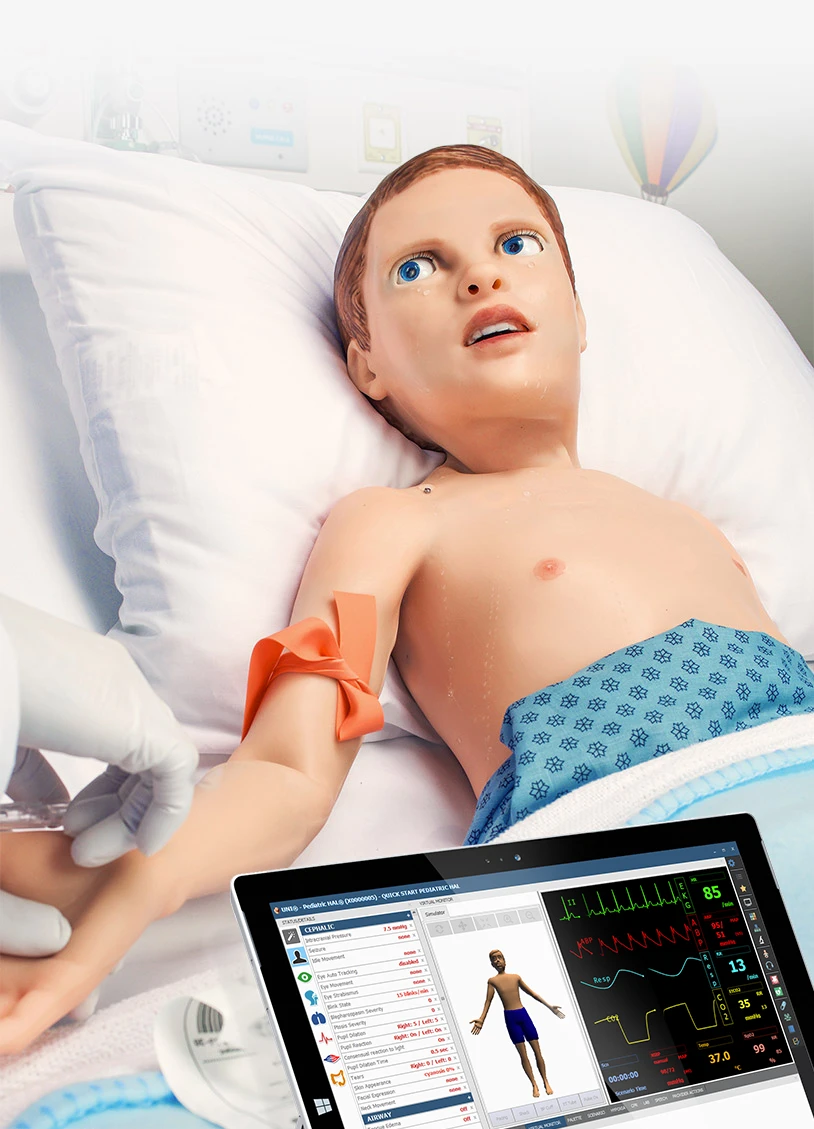
A Breakthrough in
Pediatric Patient Simulation
Pediatric HAL® is the world's most advanced pediatric patient simulator and the first capable of simulating lifelike emotions through dynamic facial expressions, movement, and speech. HAL is designed to help providers of all levels develop the specialized skills needed to effectively communicate, diagnose, and treat young patients in nearly all clinical areas.
- Interactive eyes and active facial expressions
- Dynamic lung compliance with true ventilator support
- Real patient monitor support: SpO2, EKG, capnography, NIBP, live pacing, and defibrillation
- Emergency intervention: surgical airway, needle decompression, chest tube insertion
- Wireless and tetherless
General
- Height: 44 inches
- Tetherless and wireless; fully responsive during transport
- The internal rechargeable battery provides hours of tetherless operations1
- Smooth and supple full-body skin with seamless trunk and limb joints
- Realistic joint articulation: neck, shoulder, elbow, hip, and knee
- Palpable bony landmarks
- Forearm pronation and supination
- Supports common patient positions including Fowler’s, supine, and sitting
- Male/female patient conversion
- Tablet PC preloaded with UNI® 3 included
- OMNI®2 ready
- Includes 10 preprogrammed SLEs and facilitator’s guidebook
Tetherless and Wireless Mobility
- Tetherless and fully responsive even while being transported for team training
- Internal rechargeable battery provides up to 4 hrs. of tetherless operation2
- Pneumatic and fluid reservoirs are housed inside the body
Breathing
- Spontaneous breathing and selectable normal and abnormal respiratory patterns
- Variable respiratory rates and inspiratory/expiratory ratios
- Programmable unilateral chest rise and fall
- Unilateral chest rise with right mainstem intubation
- Real CO2 exhalation: supports etCO2 monitoring using real sensors and monitoring devices
- Selectable normal and abnormal sounds: upper right front and back, upper left front and back, lower right back, and lower left back
- Mechanical ventilation support:
- AVC, SIMV, CPAP, PCV, PSV, and more
- Supports therapeutic levels of PEEP
- Programmable variable lung compliance
- Variable bronchi resistance
- Programmable respiratory efforts for weaning/liberation
- Real-time ventilation feedback
- Visible chest rise during BVM ventilation
- Chest tube insertion: left midaxillary hemothorax site features palpable bony landmarks, realistic skin for cutting and suturing, tactile pleural pop, and fluid drain
- Needle decompression site features realistic tactile feedback and audible hiss
- Needle decompression and chest tube insertion detection and logging
Airway
- Anatomically accurate oral cavity and airway
- Supports nasotracheal/orotracheal intubation with standard instruments including endotracheal tubes and supraglottic airway devices
- Tracheal intubation detection
- Head tilt, chin lift, jaw thrust
- Supports esophageal intubation
- NG/OG tube placement
- Supports bag-valve-mask ventilation
- Realistic surgical trachea permits tracheostomy, cricothyrotomy, and retrograde intubation
- Programmable difficult airway: laryngospasm and tongue edema
- Selectable normal and abnormal upper airway sounds
Circulatory
- Visible cyanosis, redness, pallor, and jaundice
- Supports capillary refill time testing above the right knee; test detection and logging
- Palpable pulses: bilateral carotid, brachial, radial, and femoral
- Blood pressure-dependent pulses
- Supports blood pressure monitoring using a real NIBP cuff and monitor
- SpO₂ monitoring using real devices
Cardiac
- Includes a comprehensive library of ECG rhythms with customizable beat variations
- Independent normal/abnormal heart sounds at aortic, pulmonic, and mitral sites
- Supports ECG monitoring using real devices
- Supports ECG-derived respiration monitoring (EDR)
- Real-time CPR quality feedback and reporting
- Time to CPR
- Compression depth/rate
- Compression interruptions
- Ventilation rate
- Excessive ventilation
- Smart CPR voice coach
- Effective chest compressions generate palpable femoral pulses
- Defibrillate, cardiovert, and pace using real devices and energy
- Anterior/posterior defibrillation sites
- Supports double sequential external defibrillation (DSED) up to 150 Joules
Neurologic
- Active robotics simulate lifelike facial expressions including:
- Anger
- Transient pain
- Ongoing pain
- Amazement
- Quizzical
- Crying
- Yawning
- Preprogrammed emotional states automatically express associated verbal and non-verbal cues without manual input
- Worried
- Anxious
- Lethargic
- Distracted
- Create custom facial expressions via UNI® 3 interface
- Programmable jaw movement, bilateral or unilateral brow movement, and horizontal neck rotation
- Automatically turns head and eyes towards the approaching subject
- Stiff neck (torticollis)
- Interactive eyes: eyes can automatically follow a moving object
- Programmable blinking rate, pupil response, and bilateral and unilateral eye movement
- Independent, active pupillary light reflex
- Abnormal eye and eyelid movements: cross-eyed, nystagmus, eyelid twitching, eyelid droop
- Programmable crying/tears release real fluid
- Wireless streaming voice: be the voice of HAL and listen to participants respond in real-time
- Real-time voice modulation effects
- Automatic jaw movement synchronized with speech
- Seizures with selectable intensity levels
- 50+ prerecorded speech responses
Vascular Access
- Bilateral forearm IV access supports sampling and continuous infusion
- Intraosseous infusion site at the right proximal tibia
- Real glucose test readings via finger-stick
Gastrointestinal
- Patent esophagus
- Gastric distension during excessive PPV
- Bowel sounds in four quadrants
- Interchangeable male/female genitalia
- Supports urinary catheterization with fluid return
- Programmable urinary output

Available Skin Tones at No Extra Charge
Light
Medium
Dark
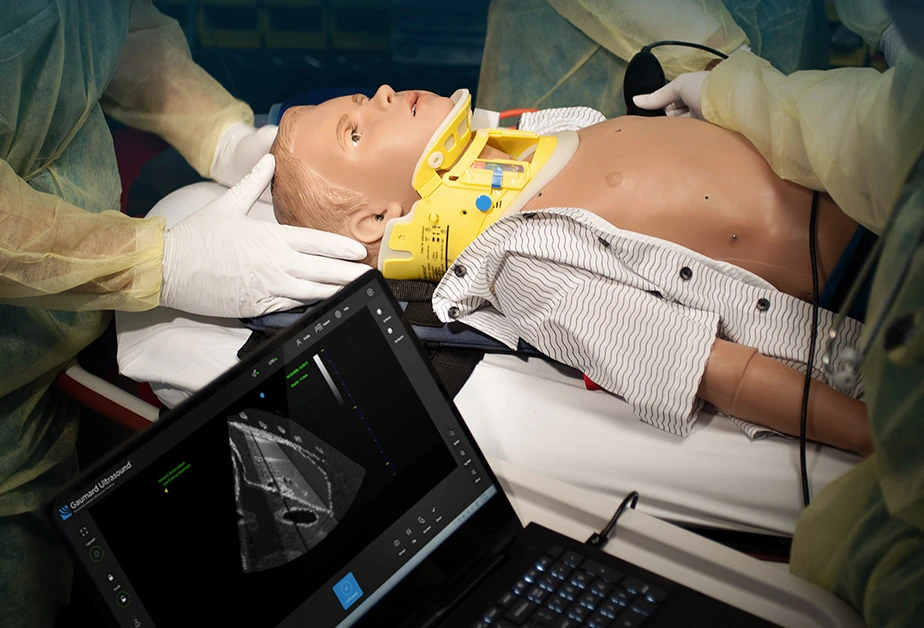
Introducing
Gaumard Ultrasound
Simulation-based
Ultrasound Training
True-to-life imaging with Gaumard Ultrasound™
Facilitate ultrasound training through full-scale immersive emergency and trauma scenarios. Gaumard Ultrasound™ simulates the function and feel of a real portable ultrasound machine. Transducer range-of-motion and imaging is dynamic and lifelike, allowing students and professionals to refine imaging skills in team-based simulation. The Pediatric Emergency POCUS/eFAST module offers you a library of emergency ultrasound case imaging covering a wide variety of trauma presentations.
Emergency Ultrasound Case Images
- Healthy
- Left Pneumothorax
- Left Hemothorax
- Right Pneumothorax
- Right Hemothorax
- Splenic Hematoma
- Splenic Rupture with Blood in Rectovesical Pouch
- Liver Laceration
- Pericardial Effusion
- Pneumoperitoneum
- Appendicitis
- Bladder Rupture
A New Level of Interaction and Richer Patient-provider Communication
Through scenario-based learning, HAL can help participants assess verbal and non-verbal cues to build patient-provider communication skills and empathy.
In addition to illustrating nearly a dozen facial expressions, HAL also simulates a variety of common emotional states to better approximate behavior. Simply set HAL's emotional state to lethargic, for example, and the eyelids will droop automatically, head movement will slow, and yawning will occur periodically. What's more, the powerful UNI software lets you create your own facial expressions and emotions to expand the scope of the learning experiences. The UNI library includes the following presets to get you started:
- Anger
- Transient Pain
- Ongoing Pain
- Amazed
- Quizzical
- Worried
- Anxious
- Crying
- Yawning
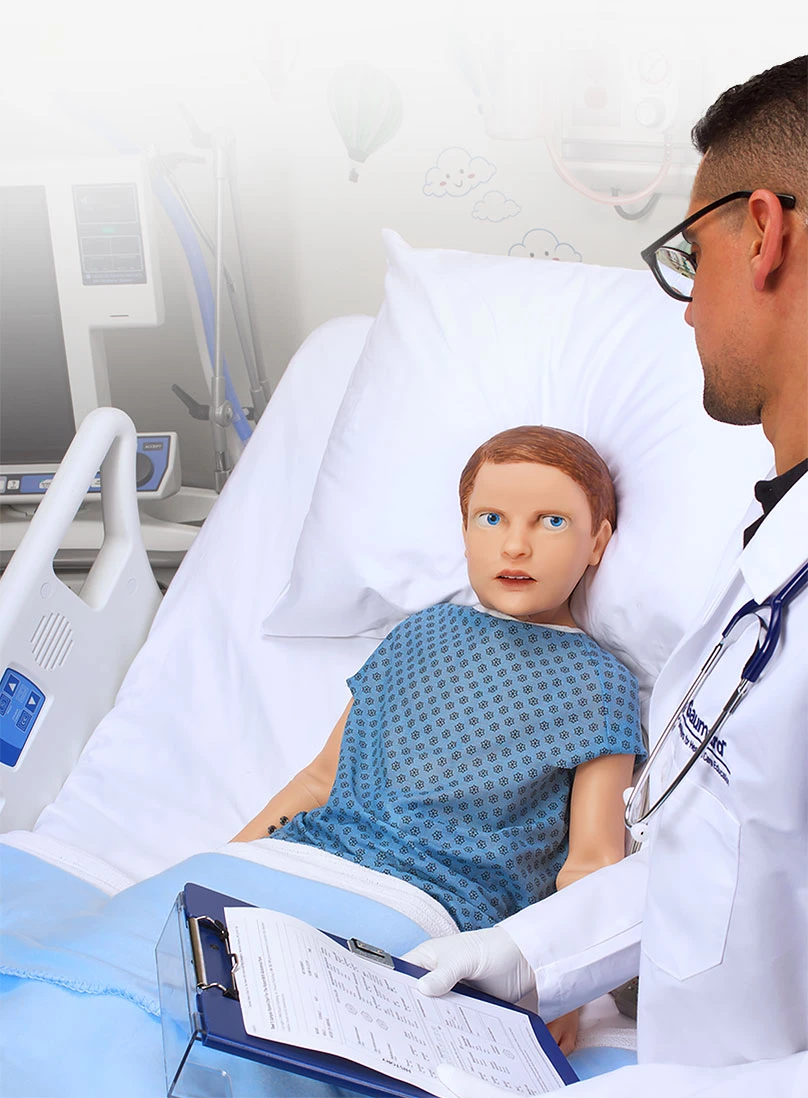
Lifelike Facial Expressions and Emotions
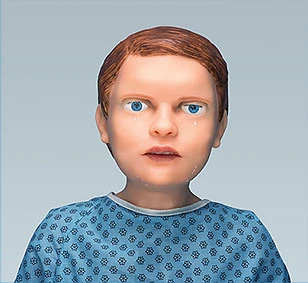
Ongoing Pain
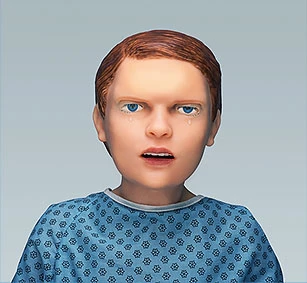
Transient Pain
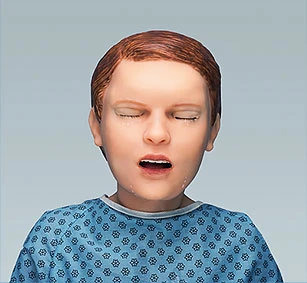
Crying
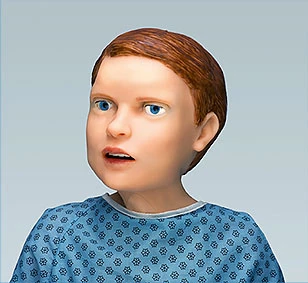
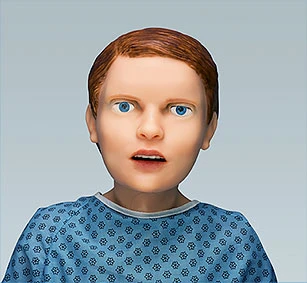
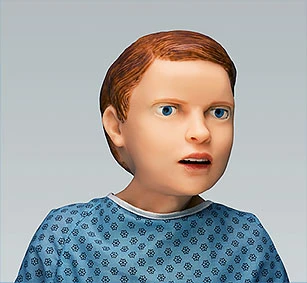
Horizontal Head Movement (Active robotics)
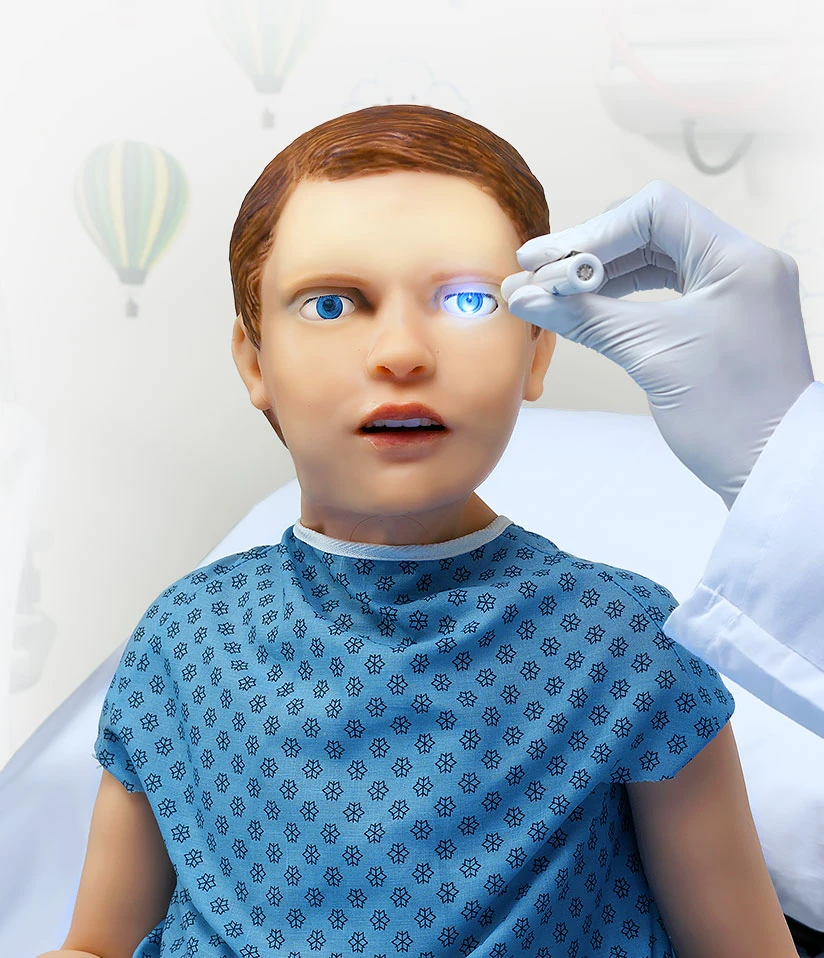
Truly Comprehensive Pediatric Patient Assessment Exercises
Interactive eyes and color-changing skin allow Pediatric HAL to illustrate signs of varying emotional states, trauma, and many other neurological diseases and conditions.
- Accommodation test: automatic horizontal tracking and manual vertical tracking
- Strabismus: exotropia and esotropia
- Nystagmus: eyeball twitching
- Blepharospasm: eyelid twitching
- Ptosis: eyelid droop
- Realistic idle eye movement
- Independent pupillary light reflex
- Mydriasis: blown pupil
- Anisocoria: unequal pupil sizes
- Programmable blinking rate
- Consensual pupillary light reflex
- Mild and severe seizures
Visual Cues of Neurologic and Physiologic Health
Horizontal Object Tracking
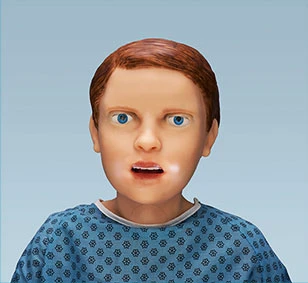
Pallor
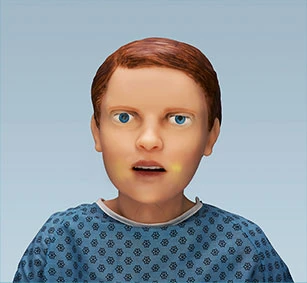
Jaundice
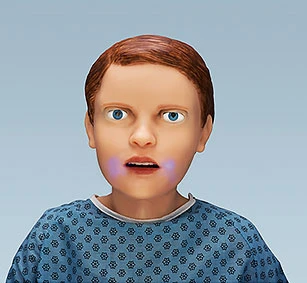
Cyanosis
- High-fidelity heart, lung, and bowel sounds
- Independent normal/abnormal heart sounds at aortic, pulmonic, and mitral sites
- Anterior and posterior lung sounds
- Spontaneous breathing and selectable normal and abnormal respiratory patterns
- Programmable unilateral chest rise and fall
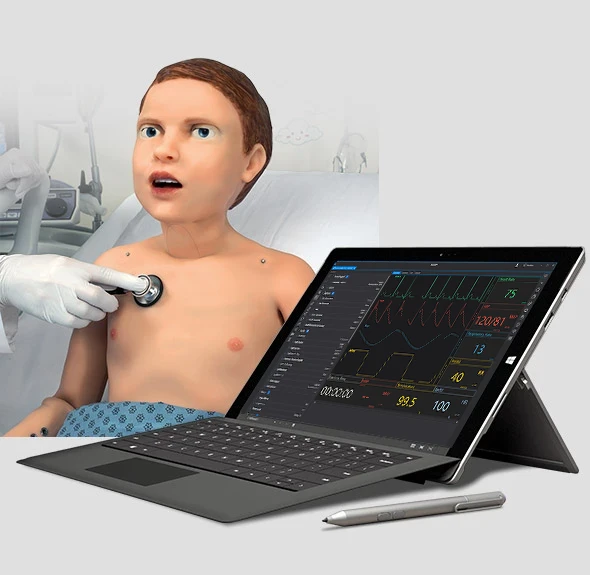
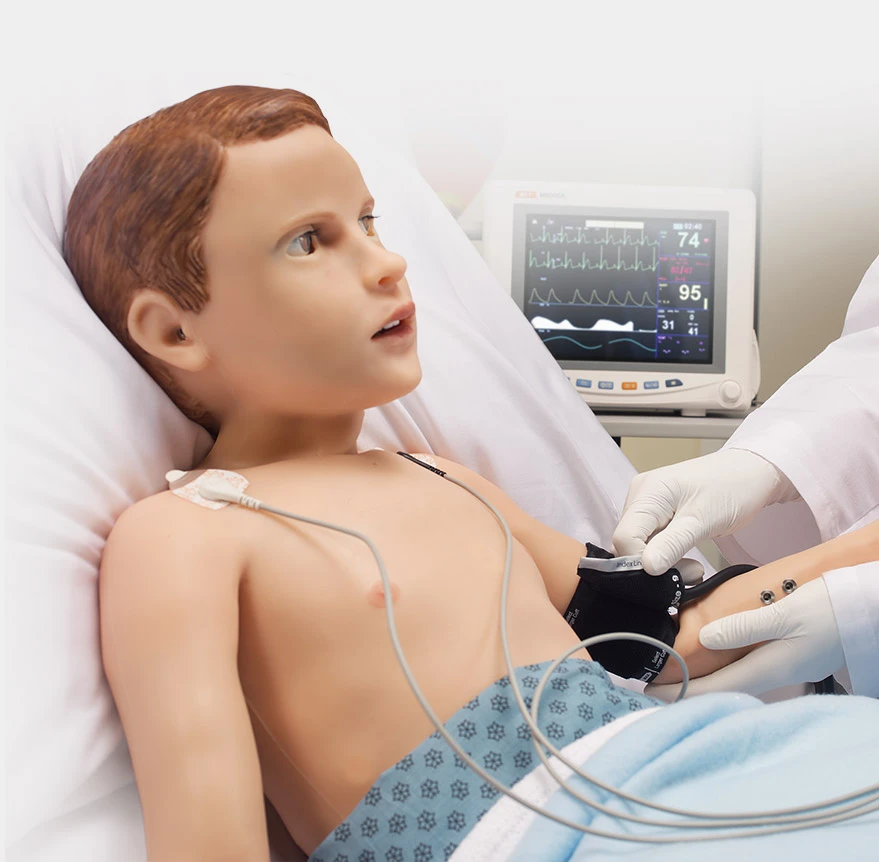
Practice Using Real Patient Monitors and Sensors
Pediatric HAL supports a broad range of real patient monitors and sensors. This unique capability allows participants to practice setting up and operating equipment just as they would in real situations.
- Oximeters
- Capnograph
- Defibrillators
- NIBP monitors
- Glucose meters
- Palpable pulses: bilateral carotid, brachial, radial, pedal, and femoral
- Bilateral forearm IV access supports sampling and continuous infusion
- Capillary refill time testing
- Blood pressure-dependent pulses
- Urinary catheterization with programmable flow
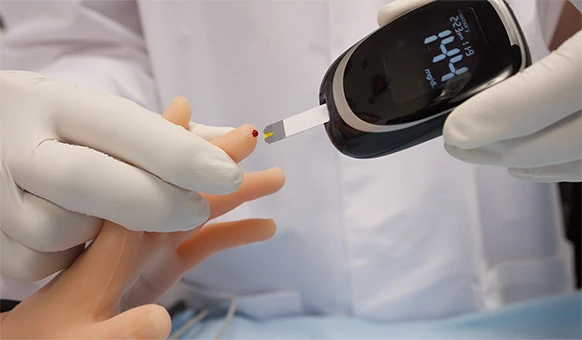
Real glucose testing via finger-stick
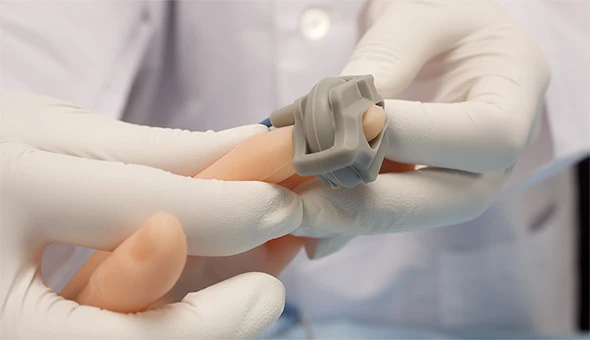
Real-time SpO2 Monitoring
The Next Generation in Pediatric Advanced Life Support Simulation
Thanks to its ultra-high fidelity, anatomical, and physiological features, Pediatric HAL supports the practice of advanced-level algorithms using real tools and clinically accurate techniques.
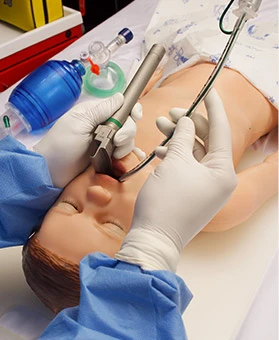
Realistic chest recoil
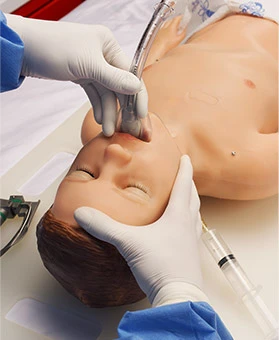
Supraglottic airway device support
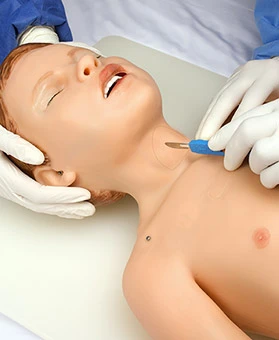
Surgical Airway
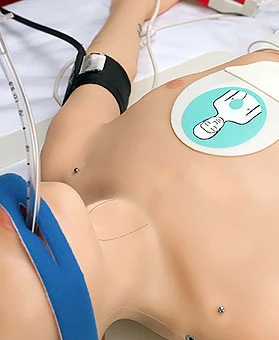
Anterior/posterior defibrillation
The Next-generation in Pediatric Advanced Life Support Simulation
Thanks to its ultra-high fidelity, anatomical, and physiological features, Pediatric HAL supports the practice of advanced-level algorithms using real tools and clinically accurate techniques.
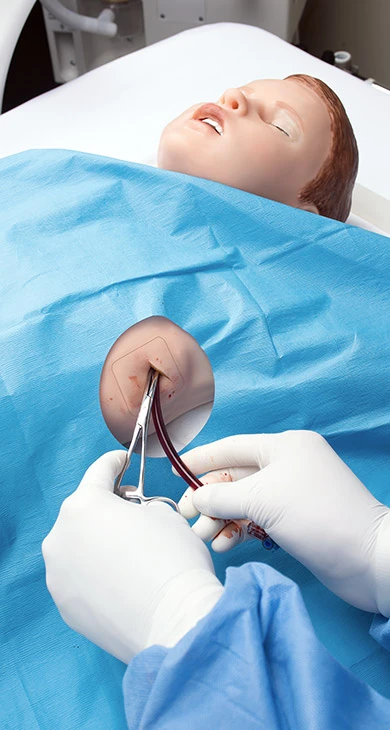
Left-midaxillary hemothorax site
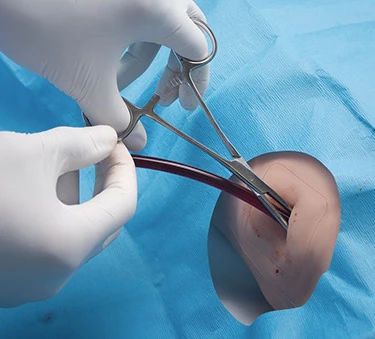
Chest tube insertion
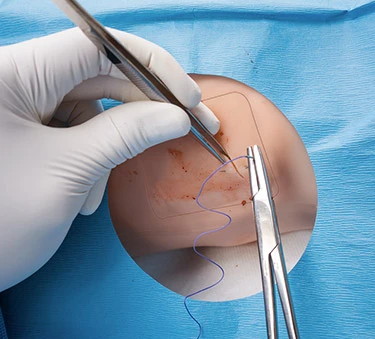
Chest tube insertion
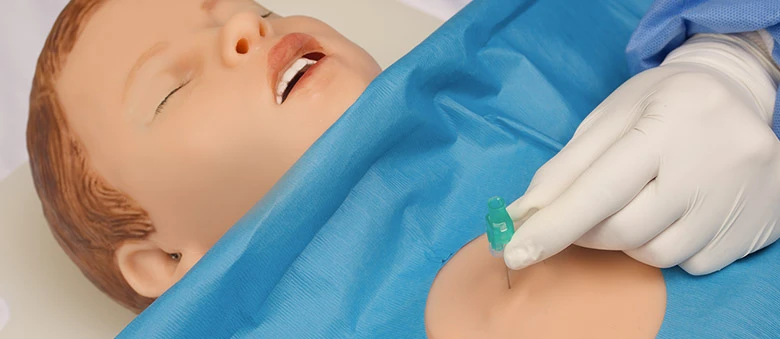
Audible air release "hiss"
- Palpable and anatomically accurate bony landmarks
- Realistic skin supports cutting and suturing
- Chest tube sites bleed when cut and release fluid upon tube insertion
- Tactile pleural "pop"
- Audible hiss during needle decompression
- Needle and chest tube insertion detection and logging
True Mechanical Ventilation Support for Advanced Respiratory Care Simulation
Pediatric HAL responds to mechanical ventilation support using real equipment just like a real patient. Simulate the course of respiratory disease through treatment, weaning, and rehabilitation with the highest degree of physiological accuracy. The patented dynamic lung system in Pediatric HAL requires no manual calibration, external intermediary adapters, or setup boxes. Simply connect HAL to the ventilator and tap the UNI controls to change lung functionality on the fly.
- Modes supported include: ACV, SIMV, CPAP, PCV, PSV
- Programmable respiratory patterns
- Supports therapeutic levels of PEEP
- Programmable airway and lung functions
- Dynamic lung compliance (low to high)
- Bilateral bronchi resistance
- Respiratory effort triggers ventilator during weaning
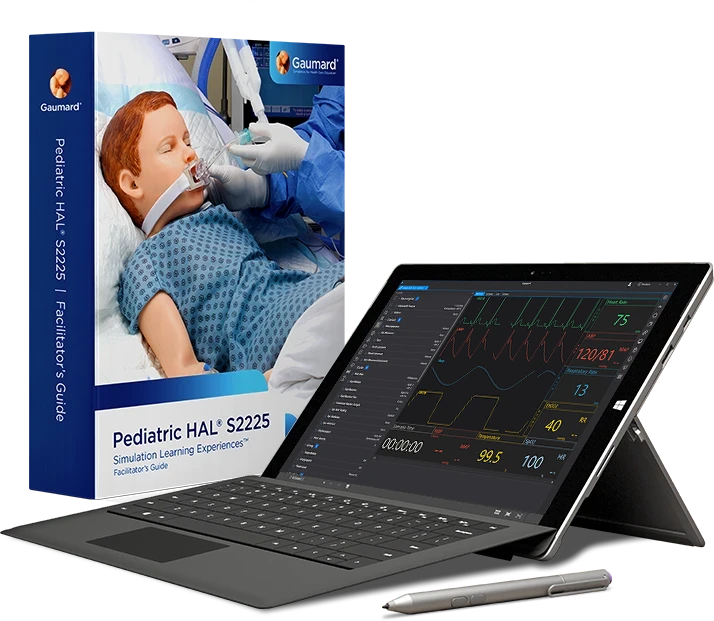
Ready-to-Run in Your Program with Simulation Made Easy®
Pediatric HAL is a complete learning solution and includes everything you need to get started, including the powerful UNI® Tablet PC and 10 Simulation Learning Experiences.
- Acute Lymphocytic Leukemia (ALL)
- Appendicitis
- Post-Op Cardiac Transplant
- Potential Organophosphate Poisoning
- Respiratory Syncytial Virus (RSV)
- Sepsis In A Six-Year-Old
- Seizure Management
- Status Asthmaticus
- Trauma Related To Child Abuse
- Four-Year-Old With Trauma
UNI offers all the tools to deliver a rich simulation experience in one intuitive interface. It features precise physiological touch-based controls, task automation, real-time feedback, and automatic data capture tools designed to operate seamlessly during even the most complex scenarios.
1. Battery life estimates are dependent on active features and settings; results may vary.
Priced without options, discounts, or special offers. Taxes and other fees are not included. Extended service plans, product installation, and training services are available. Product design and price are subject to change without notice. All trademarks and/or copyright materials are the property of their respective owners. © 2020 Gaumard Scientific. Patented; other patents pending. All Rights Reserved.
